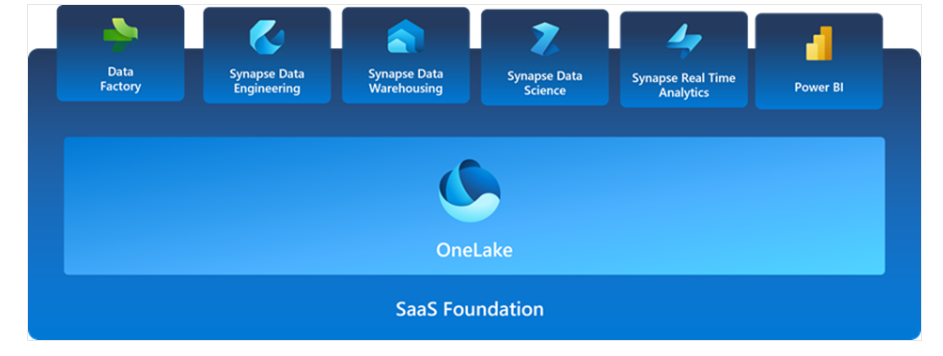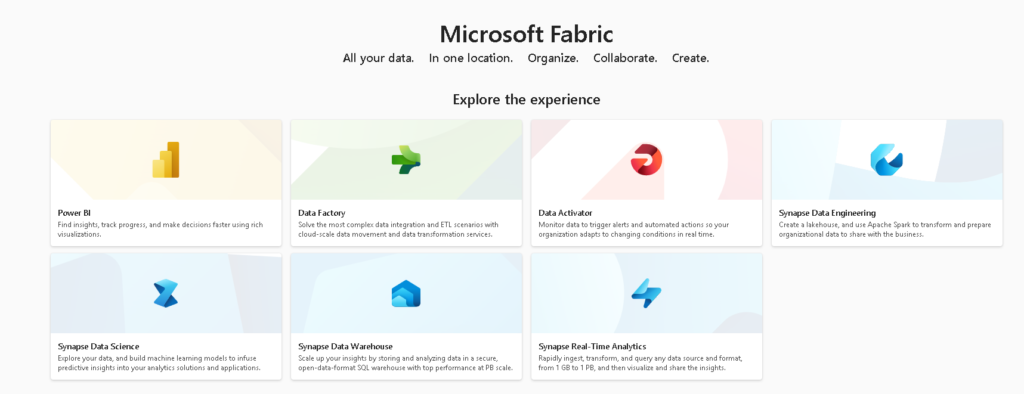Microsoft Fabric is end-to-end, cloud-based SaaS analytics platform where data experts and business teams can work together on data projects in one shared space.
Microsoft Fabric represents an innovative AI-driven analytics platform that consolidates data and services sourced from various outlets like Power BI, Azure Synapse, and Azure Data Factory.
Fabric consolidates various experiences like Data Engineering, Data Factory, Data Science, Data Warehouse, Real-Time Analytics, and Power BI onto a unified Software as a Service (SaaS) platform.

Source: Microsoft learn
Why Microsoft Fabric – An umbrella?
Microsoft Fabric is a combination of three existing Microsoft products Power BI, Azure Data Factory and Azure synapse. Its acts as an umbrella for all data analytics services from Microsoft that integrates various data technologies and tools into a single solution.
Fabric offers a single data repository, or data lake, accessible to data engineers, analysts, scientists, and business users without data duplication. Integrated within the Fabric service, it establishes a centralized space to store all organizational data, facilitating the operation of various experiences within a unified location.
Components of Microsoft Fabric
Microsoft fabric offers tailored experiences for diverse roles and tasks, encompassing areas like Power BI, Data factory, Data engineering, Data science, Real-time analytics, and Data Activator. Moreover, it features a unified data lake, enabling data retention in its original locations while supporting the use of preferred analytics tools.

Source: Microsoft learn
Power BI
Power BI is a dynamic business intelligence tool that empowers users to gather, analyse, and visualize data from various sources, allowing for informed decision-making through interactive reports and dashboards. This tool is user-friendly, enabling both technical and non-technical users to explore data, discover insights, and share information across an organization.
Data Factory
Azure Data Factory is a cloud-based data integration service provided by Microsoft Azure. It allows you to create, schedule, and manage data pipelines that move and transform data from various sources. Data Factory enables users to extract, transform, and load (ETL) data for analytics, business intelligence, or data warehousing purposes. This tool helps in orchestrating and automating the movement and transformation of data, both on-premises and in the cloud
Data Engineering
Data engineering using Spark typically involves leveraging Apache Spark, an open-source distributed computing system, for processing and handling large volumes of data. Spark is known for its speed and versatility, making it a popular choice for data engineers working on big data projects.
Microsoft Fabric Spark’s fusion with Data Factory allows for scheduling and orchestrating notebooks and Spark jobs.
Data Science
The Data Science experience facilitates the smooth construction, deployment, and operationalization of machine learning models within your Fabric environment.
Data Warehouse
A data warehouse is a central repository for storing and managing large amounts of structured and often historical data from various sources within an organization. It’s designed to facilitate reporting, analysis, and decision-making by consolidating data from different departments and systems.
Real-Time analytics
Real-time analytics refers to the process of collecting, processing, analysing, and delivering insights or information on data as it occurs.
Data Activator
Data Activator in Microsoft Fabric offers no-code solution to automatically trigger action when it notices changes in data. It keeps an eye on data in reports and checks if it reaches certain levels or follows specific patterns. When this happens, it can send alerts or start tasks without needing any complicated code.
Fabric brings all kinds of different experiences together in one place, creating a complete solution for analysing big data. It helps both companies and people to turn huge and complex data collections into useful tools and insights.
Fabric Terminologies
The following are the fabric terminologies need to know before getting into Microsoft Fabric.
- Tenant – A “tenant” in Fabric refers to one unique setup of the platform specifically designed for an organization. It’s closely connected to an Azure Active Directory, which helps manage user access and permissions.
- Workspace – Workspace is a place to create collection of items such as report, data warehouses, lakehouses. It is a single environment that designed to collaborate and provide controls for who can access in it.
- Capacity – A capacity exists within a tenant. Each capacity linked to a particular tenant represents a separate set of resources dedicated to Microsoft Fabric. The capacity’s size dictates the level of computational power accessible.
- Experience – A collection of capabilities targeted to a specific functionality.
- Item – An “item” comprises a collection of abilities within an experience. Users have the ability to generate, modify, and remove these items. Each type of item offers distinct capabilities.
| Tags | Microsoft Fabric |
| Useful links | |
| MS Learn Modules | |
Test Your Knowledge |
